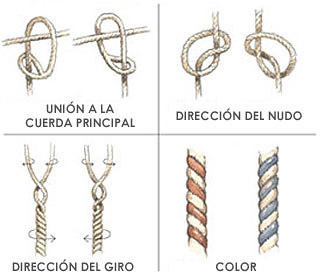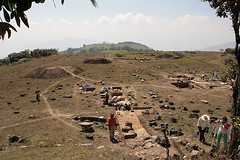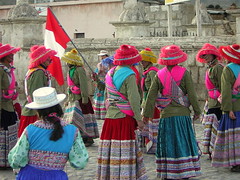Unlocking the secrets of the Quipus
By Enrique Sánchez for El Comercio
 Gary Urton. The investigator from Harvard University reveals the latest results of his investigations of the meaning of the quipu.
Gary Urton. The investigator from Harvard University reveals the latest results of his investigations of the meaning of the quipu.
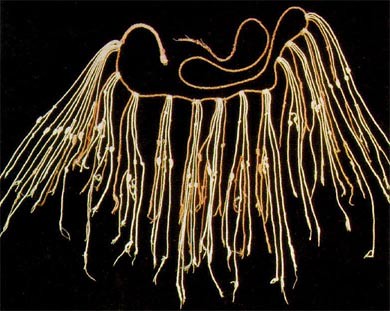 As I explained in this previous post, the quipu (or khipu) is a fascinating communication device used in the pre-Columbian world for everything from accounting and record keeping to, it is believed, recording detailed text… names, words, a full written language not in symbols but in lengths of string and knots tied at points along them.
As I explained in this previous post, the quipu (or khipu) is a fascinating communication device used in the pre-Columbian world for everything from accounting and record keeping to, it is believed, recording detailed text… names, words, a full written language not in symbols but in lengths of string and knots tied at points along them.
The man at the forefront of their study is Gary Urton, professor of pre-Columbian studies in Harvard’s Department of Archaeology. Considered the world’s eminent authority on deciphering the quipu system, his investigations have kept him for a number of years in Andean Peru studying examples never before examined including many great finds from Chachapoyas.
Quipu discoveries have increased since the 60’s – until when examples found by famous archaeologist Julio C. Tello in the decade before, all from the Inca period, caused him to think they were invented by the Incas. Changing in 1968 when quipus were discovered from the pre-Inca Wari civilisation in 1968, we have since found examples going back to the earliest civilisations in South America, including at 5000 year old Caral.
Gary Urton spoke to El Comercio on the subject and on his recent work.
What material did you have for your studies on the quipu?
I started studying quipus that were in museum collections in Europe, Peru, Chile and the US. In 1992 I worked on a collection that had between 300 to 315 examples. Today, in different museums across the world there are about 800 quipus, although there must be many more in private collections – maybe 1000 or more.
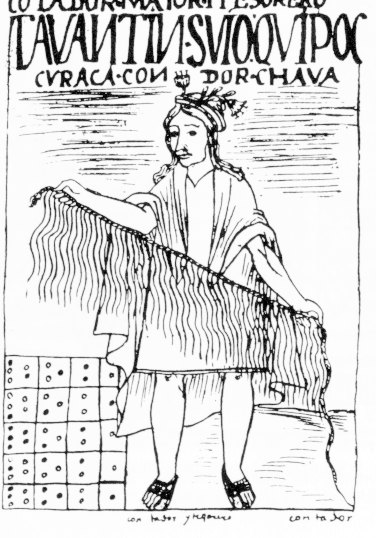
A skilled Quipucamayoc, quipu creator and reader
What did you concentrate on?
What I did was study the construction of the knots and the why the threads were made. In some cases the threads were woven to the right and others to the left. Studying the knots meticulously I discovered that they were knotted in different ways: one tied around its axis in a “s” shape, the other in a “z” shape. (Dear Reader: If you can explain this, please do enlighten me in the comments below!) Up till now we’ve studied 60,000 knots, all from quipus belonging to the Inca period.
Since you began studying quipus, how have your theories changed?
The first thing I found were very important variations in records kept about quipus. In the past researchers worried more about the numbers that the quipus recorded, what they were counting, but no-one studied the structures nor the variations of the knots, nor the way the threads were woven. After some years I had the idea that maybe these variations in knot structure had something to do with the data recorded on the quipu. The way the knot was tied or attached to the main belt could be a way of recording more detailed information.
What help has modern technology provided to your studies?
At Harvard we have developed a computer program to record the information and patterns of the structure of each quipu. This helps us study the regularities and irregularities of the knots.
Have you managed to determine what they were for?
There is not one single answer and it’s not that simple. Some were clearly used to record statistics regarding population census, taxes, state resources; others record events such as wars, alliances etc. The Spanish chroniclers tell us of these distinct functions. We are trying to find out if this helps us determine what the patterns could mean – trying to match them with the history recorded by the chronicles.
How do you think the quipus record historic information?
It is difficult to be certain. The sure thing is that they record quantities. The other values are recorded in the details, like the colours, the torsion of the threads, and the style of knot tying. Just like we can write with 26 letters of the alphabet, they could assign conventions to each thread, weave and knot. At the start of the conquest the Spanish knew that the quipus recorded information for the Inca state – they even provided some transcriptions. There are about two dozen of these, knot for knot, thread by thread, but what there isn’t is a correlation between one of these transcriptions and an existing quipu. If we could find a quipu that had been transcribed by the Spanish, we could immediately decipher all of them.
Are the quipus found in different regions very different?
No very. We have identified between 12 and 15 zones where quipus were used, from Chachapoyas in the north to Arica in the south. The majority come from the coast because the dry climate is able to keep them better preserved. We have discovered that certain regions used colours in groups of 5, in others 4, and other 3 and 2 at a time. This must be something to do with the conventions used in each part of the empire to identify each region.
You can find out more about the Quipu here, where Gary Urton describes the discovery of the first word written in a quipu, the place name of a Inca administration centre in Lima. You can also see how numbers were counted on a quipu.
Vist Gary Urton’s project website here.
Tags: arica, chachapoyas, gary urton, incas, julio c. tello, quipu, textiles, wari, weaving


